An official website of the United States government
 United States Department of Labor
United States Department of Labor
Study the composition, structure, and other physical aspects of the Earth. May use geological, physics, and mathematics knowledge in exploration for oil, gas, minerals, or underground water; or in waste disposal, land reclamation, or other environmental problems. May study the Earth’s internal composition, atmospheres, and oceans, and its magnetic, electrical, and gravitational forces. Includes mineralogists, paleontologists, stratigraphers, geodesists, and seismologists.
Employment estimate and mean wage estimates for Geoscientists, Except Hydrologists and Geographers:
| Employment (1) | Employment RSE (3) |
Mean hourly wage |
Mean annual wage (2) |
Wage RSE (3) |
|---|---|---|---|---|
| 24,620 | 3.8 % | $ 50.00 | $ 104,000 | 1.1 % |
Percentile wage estimates for Geoscientists, Except Hydrologists and Geographers:
| Percentile | 10% | 25% | 50% (Median) |
75% | 90% |
|---|---|---|---|---|---|
| Hourly Wage | $ 25.24 | $ 31.87 | $ 44.51 | $ 61.29 | $ 82.98 |
| Annual Wage (2) | $ 52,500 | $ 66,280 | $ 92,580 | $ 127,480 | $ 172,600 |
Industries with the highest published employment and wages for Geoscientists, Except Hydrologists and Geographers are provided. For a list of all industries with employment in Geoscientists, Except Hydrologists and Geographers, see the Create Customized Tables function.
Industries with the highest levels of employment in Geoscientists, Except Hydrologists and Geographers:
| Industry | Employment (1) | Percent of industry employment | Hourly mean wage | Annual mean wage (2) |
|---|---|---|---|---|
| Architectural, Engineering, and Related Services | 8,580 | 0.52 | $ 46.76 | $ 97,260 |
| Management, Scientific, and Technical Consulting Services | 3,890 | 0.21 | $ 41.44 | $ 86,200 |
| Federal, State, and Local Government, excluding State and Local Government Schools and Hospitals and the U.S. Postal Service (OEWS Designation) | 2,200 | 0.10 | $ 54.62 | $ 113,610 |
| State Government, excluding Schools and Hospitals (OEWS Designation) | 2,090 | 0.10 | $ 41.86 | $ 87,080 |
| Oil and Gas Extraction | 1,910 | 1.76 | $ 75.28 | $ 156,580 |
Industries with the highest concentration of employment in Geoscientists, Except Hydrologists and Geographers:
| Industry | Employment (1) | Percent of industry employment | Hourly mean wage | Annual mean wage (2) |
|---|---|---|---|---|
| Oil and Gas Extraction | 1,910 | 1.76 | $ 75.28 | $ 156,580 |
| Metal Ore Mining | 540 | 1.26 | $ 51.60 | $ 107,330 |
| Architectural, Engineering, and Related Services | 8,580 | 0.52 | $ 46.76 | $ 97,260 |
| Support Activities for Mining | 1,130 | 0.40 | $ 45.60 | $ 94,840 |
| Lessors of Nonfinancial Intangible Assets (except Copyrighted Works) | 90 | 0.40 | $ 57.07 | $ 118,700 |
Top paying industries for Geoscientists, Except Hydrologists and Geographers:
| Industry | Employment (1) | Percent of industry employment | Hourly mean wage | Annual mean wage (2) |
|---|---|---|---|---|
| Management of Companies and Enterprises | 1,060 | 0.04 | $ 81.19 | $ 168,880 |
| Natural Gas Distribution | 30 | 0.03 | $ 75.65 | $ 157,340 |
| Oil and Gas Extraction | 1,910 | 1.76 | $ 75.28 | $ 156,580 |
| Machinery Manufacturing (3331, 3332, 3334, and 3339 only) | 110 | 0.01 | $ 68.94 | $ 143,390 |
| Electric Power Generation, Transmission and Distribution | 50 | 0.01 | $ 64.11 | $ 133,360 |
States and areas with the highest published employment, location quotients, and wages for Geoscientists, Except Hydrologists and Geographers are provided. For a list of all areas with employment in Geoscientists, Except Hydrologists and Geographers, see the Create Customized Tables function.
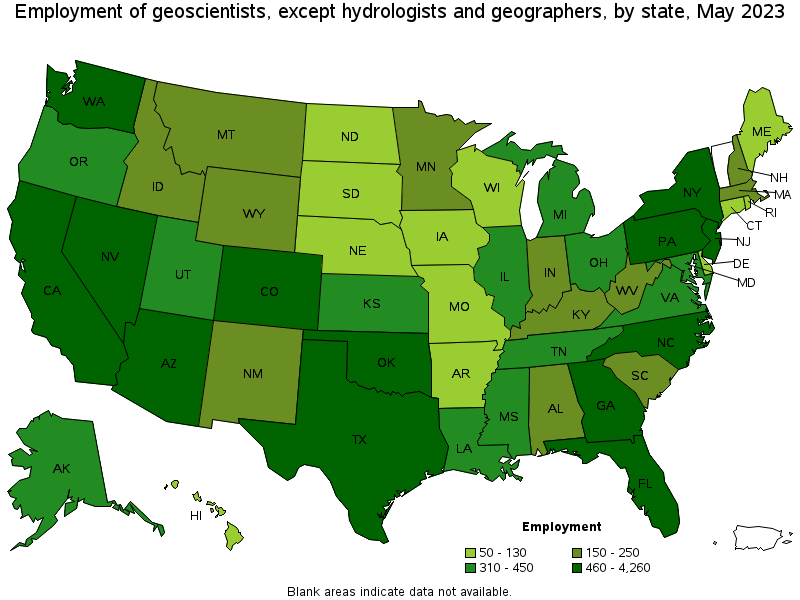
States with the highest employment level in Geoscientists, Except Hydrologists and Geographers:
| State | Employment (1) | Employment per thousand jobs | Location quotient (9) | Hourly mean wage | Annual mean wage (2) |
|---|---|---|---|---|---|
| California | 4,260 | 0.24 | 1.47 | $ 52.08 | $ 108,330 |
| Texas | 4,020 | 0.30 | 1.83 | $ 67.20 | $ 139,770 |
| Colorado | 1,670 | 0.59 | 3.64 | $ 58.61 | $ 121,910 |
| Washington | 1,080 | 0.31 | 1.90 | $ 49.56 | $ 103,090 |
| Oklahoma | 960 | 0.57 | 3.54 | $ 52.34 | $ 108,870 |
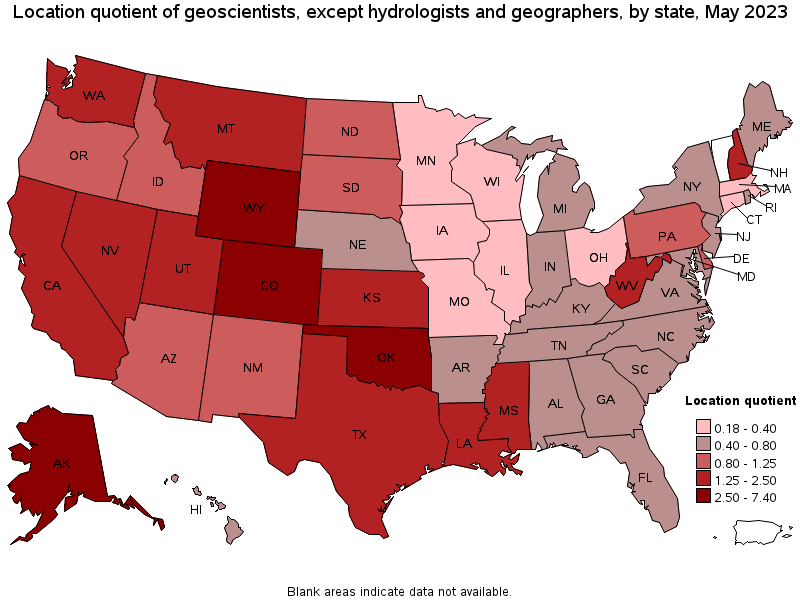
States with the highest concentration of jobs and location quotients in Geoscientists, Except Hydrologists and Geographers:
| State | Employment (1) | Employment per thousand jobs | Location quotient (9) | Hourly mean wage | Annual mean wage (2) |
|---|---|---|---|---|---|
| Alaska | 370 | 1.20 | 7.40 | $ 50.85 | $ 105,780 |
| Wyoming | 190 | 0.69 | 4.28 | $ 42.14 | $ 87,650 |
| Colorado | 1,670 | 0.59 | 3.64 | $ 58.61 | $ 121,910 |
| Oklahoma | 960 | 0.57 | 3.54 | $ 52.34 | $ 108,870 |
| Montana | 190 | 0.37 | 2.30 | $ 40.24 | $ 83,710 |
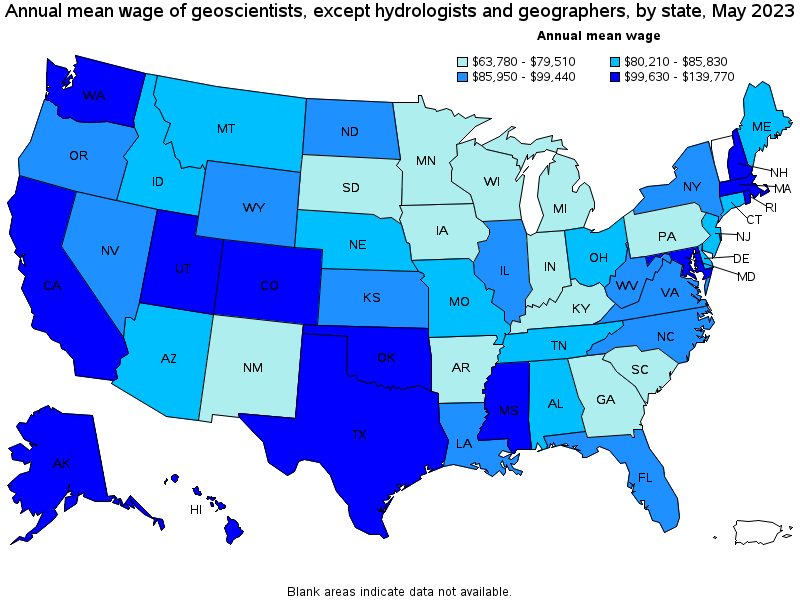
Top paying states for Geoscientists, Except Hydrologists and Geographers:
| State | Employment (1) | Employment per thousand jobs | Location quotient (9) | Hourly mean wage | Annual mean wage (2) |
|---|---|---|---|---|---|
| Texas | 4,020 | 0.30 | 1.83 | $ 67.20 | $ 139,770 |
| Colorado | 1,670 | 0.59 | 3.64 | $ 58.61 | $ 121,910 |
| Oklahoma | 960 | 0.57 | 3.54 | $ 52.34 | $ 108,870 |
| California | 4,260 | 0.24 | 1.47 | $ 52.08 | $ 108,330 |
| Utah | 390 | 0.23 | 1.42 | $ 51.15 | $ 106,380 |
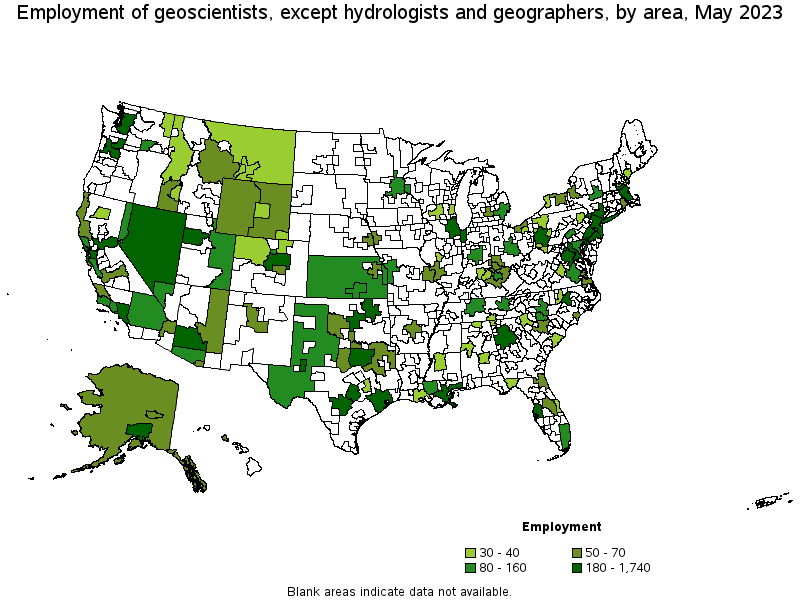
Metropolitan areas with the highest employment level in Geoscientists, Except Hydrologists and Geographers:
| Metropolitan area | Employment (1) | Employment per thousand jobs | Location quotient (9) | Hourly mean wage | Annual mean wage (2) |
|---|---|---|---|---|---|
| Houston-The Woodlands-Sugar Land, TX | 1,740 | 0.55 | 3.38 | $ 76.98 | $ 160,110 |
| Los Angeles-Long Beach-Anaheim, CA | 1,210 | 0.20 | 1.21 | $ 52.78 | $ 109,790 |
| Denver-Aurora-Lakewood, CO | 1,120 | 0.70 | 4.34 | $ 59.43 | $ 123,600 |
| New York-Newark-Jersey City, NY-NJ-PA | 800 | 0.08 | 0.52 | $ 41.13 | $ 85,540 |
| Seattle-Tacoma-Bellevue, WA | 730 | 0.35 | 2.17 | $ 50.65 | $ 105,360 |
| San Francisco-Oakland-Hayward, CA | 670 | 0.28 | 1.71 | $ 57.20 | $ 118,970 |
| Austin-Round Rock, TX | 590 | 0.48 | 2.93 | $ 61.52 | $ 127,960 |
| Sacramento--Roseville--Arden-Arcade, CA | 560 | 0.53 | 3.27 | $ 52.02 | $ 108,210 |
| Dallas-Fort Worth-Arlington, TX | 520 | 0.13 | 0.82 | $ 64.51 | $ 134,170 |
| Oklahoma City, OK | 520 | 0.80 | 4.92 | $ 52.70 | $ 109,610 |
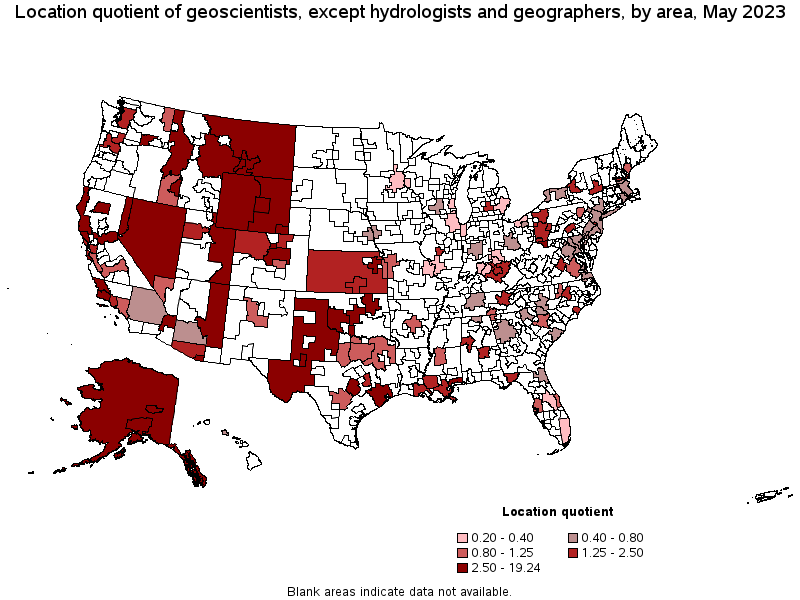
Metropolitan areas with the highest concentration of jobs and location quotients in Geoscientists, Except Hydrologists and Geographers:
| Metropolitan area | Employment (1) | Employment per thousand jobs | Location quotient (9) | Hourly mean wage | Annual mean wage (2) |
|---|---|---|---|---|---|
| Midland, TX | 360 | 3.12 | 19.24 | $ 65.67 | $ 136,590 |
| Fairbanks, AK | 70 | 2.02 | 12.49 | $ 44.33 | $ 92,210 |
| Gulfport-Biloxi-Pascagoula, MS | 200 | 1.33 | 8.22 | $ 51.79 | $ 107,720 |
| Anchorage, AK | 220 | 1.29 | 7.99 | $ 48.83 | $ 101,560 |
| Casper, WY | 40 | 1.15 | 7.12 | $ 47.83 | $ 99,490 |
| Cheyenne, WY | 40 | 0.88 | 5.44 | $ 40.33 | $ 83,880 |
| Oklahoma City, OK | 520 | 0.80 | 4.92 | $ 52.70 | $ 109,610 |
| Denver-Aurora-Lakewood, CO | 1,120 | 0.70 | 4.34 | $ 59.43 | $ 123,600 |
| Boulder, CO | 140 | 0.70 | 4.33 | $ 62.86 | $ 130,740 |
| Tulsa, OK | 290 | 0.65 | 4.03 | $ 55.06 | $ 114,520 |
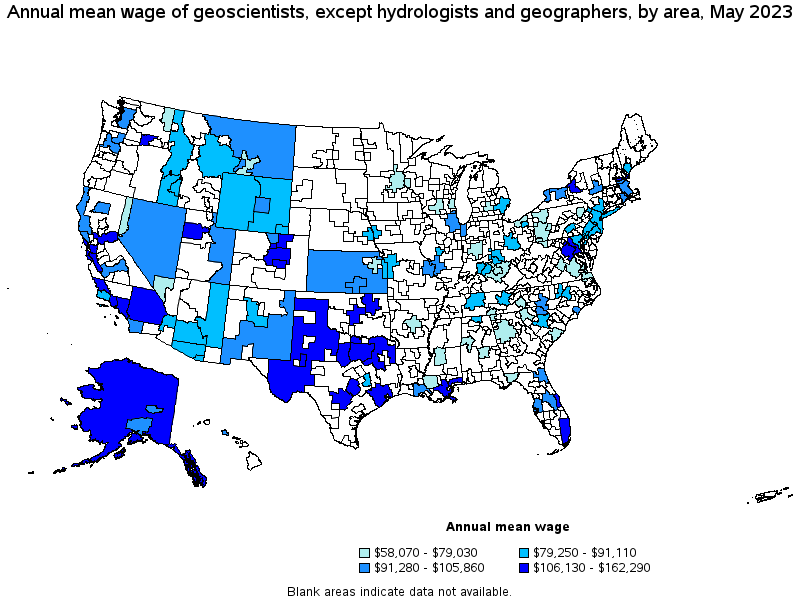
Top paying metropolitan areas for Geoscientists, Except Hydrologists and Geographers:
| Metropolitan area | Employment (1) | Employment per thousand jobs | Location quotient (9) | Hourly mean wage | Annual mean wage (2) |
|---|---|---|---|---|---|
| Greeley, CO | 40 | 0.40 | 2.46 | $ 78.03 | $ 162,290 |
| Houston-The Woodlands-Sugar Land, TX | 1,740 | 0.55 | 3.38 | $ 76.98 | $ 160,110 |
| Midland, TX | 360 | 3.12 | 19.24 | $ 65.67 | $ 136,590 |
| Palm Bay-Melbourne-Titusville, FL | 40 | 0.17 | 1.07 | $ 64.68 | $ 134,540 |
| Dallas-Fort Worth-Arlington, TX | 520 | 0.13 | 0.82 | $ 64.51 | $ 134,170 |
| Boulder, CO | 140 | 0.70 | 4.33 | $ 62.86 | $ 130,740 |
| Austin-Round Rock, TX | 590 | 0.48 | 2.93 | $ 61.52 | $ 127,960 |
| Denver-Aurora-Lakewood, CO | 1,120 | 0.70 | 4.34 | $ 59.43 | $ 123,600 |
| San Jose-Sunnyvale-Santa Clara, CA | 160 | 0.14 | 0.89 | $ 59.05 | $ 122,820 |
| Syracuse, NY | 70 | 0.24 | 1.50 | $ 57.69 | $ 120,000 |
Nonmetropolitan areas with the highest employment in Geoscientists, Except Hydrologists and Geographers:
| Nonmetropolitan area | Employment (1) | Employment per thousand jobs | Location quotient (9) | Hourly mean wage | Annual mean wage (2) |
|---|---|---|---|---|---|
| Nevada nonmetropolitan area | 200 | 2.00 | 12.33 | $ 49.83 | $ 103,650 |
| West Texas Region of Texas nonmetropolitan area | 100 | 0.51 | 3.14 | $ 58.75 | $ 122,200 |
| Eastern Utah nonmetropolitan area | 90 | 1.03 | 6.35 | $ 48.46 | $ 100,790 |
| Kansas nonmetropolitan area | 80 | 0.22 | 1.33 | $ 46.53 | $ 96,790 |
| Alaska nonmetropolitan area | 70 | 0.69 | 4.29 | $ 63.90 | $ 132,900 |
Nonmetropolitan areas with the highest concentration of jobs and location quotients in Geoscientists, Except Hydrologists and Geographers:
| Nonmetropolitan area | Employment (1) | Employment per thousand jobs | Location quotient (9) | Hourly mean wage | Annual mean wage (2) |
|---|---|---|---|---|---|
| Nevada nonmetropolitan area | 200 | 2.00 | 12.33 | $ 49.83 | $ 103,650 |
| Southwest Oklahoma nonmetropolitan area | 70 | 1.08 | 6.63 | (8) | (8) |
| Eastern Utah nonmetropolitan area | 90 | 1.03 | 6.35 | $ 48.46 | $ 100,790 |
| Alaska nonmetropolitan area | 70 | 0.69 | 4.29 | $ 63.90 | $ 132,900 |
| East-Central Montana nonmetropolitan area | 40 | 0.69 | 4.25 | $ 45.95 | $ 95,570 |
Top paying nonmetropolitan areas for Geoscientists, Except Hydrologists and Geographers:
| Nonmetropolitan area | Employment (1) | Employment per thousand jobs | Location quotient (9) | Hourly mean wage | Annual mean wage (2) |
|---|---|---|---|---|---|
| Alaska nonmetropolitan area | 70 | 0.69 | 4.29 | $ 63.90 | $ 132,900 |
| West Texas Region of Texas nonmetropolitan area | 100 | 0.51 | 3.14 | $ 58.75 | $ 122,200 |
| North Texas Region of Texas nonmetropolitan area | 50 | 0.18 | 1.11 | $ 55.66 | $ 115,780 |
| Nevada nonmetropolitan area | 200 | 2.00 | 12.33 | $ 49.83 | $ 103,650 |
| Eastern New Mexico nonmetropolitan area | (8) | (8) | (8) | $ 48.60 | $ 101,090 |
These estimates are calculated with data collected from employers in all industry sectors, all metropolitan and nonmetropolitan areas, and all states and the District of Columbia. The top employment and wage figures are provided above. The complete list is available in the downloadable XLS files.
The percentile wage estimate is the value of a wage below which a certain percent of workers fall. The median wage is the 50th percentile wage estimate—50 percent of workers earn less than the median and 50 percent of workers earn more than the median. More about percentile wages.
(1) Estimates for detailed occupations do not sum to the totals because the totals include occupations not shown separately. Estimates do not include self-employed workers.
(2) Annual wages have been calculated by multiplying the hourly mean wage by a "year-round, full-time" hours figure of 2,080 hours; for those occupations where there is not an hourly wage published, the annual wage has been directly calculated from the reported survey data.
(3) The relative standard error (RSE) is a measure of the reliability of a survey statistic. The smaller the relative standard error, the more precise the estimate.
(8) Estimate not released.
(9) The location quotient is the ratio of the area concentration of occupational employment to the national average concentration. A location quotient greater than one indicates the occupation has a higher share of employment than average, and a location quotient less than one indicates the occupation is less prevalent in the area than average.
Other OEWS estimates and related information:
May 2023 National Occupational Employment and Wage Estimates
May 2023 State Occupational Employment and Wage Estimates
May 2023 Metropolitan and Nonmetropolitan Area Occupational Employment and Wage Estimates
May 2023 National Industry-Specific Occupational Employment and Wage Estimates
Last Modified Date: April 3, 2024